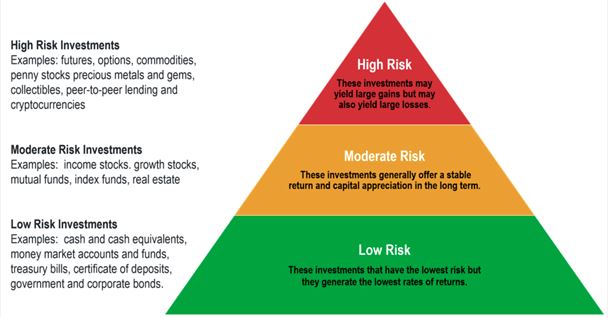How to Assess the Risk Level of Different Investments

How to Assess the Risk Level of Different Investments
When it comes to investing, understanding the risk associated with various options is essential for making informed decisions that align with your financial goals and risk tolerance. Here’s a comprehensive guide on how to assess the risk level of different investments.
How to Assess the Risk Level of Different Investments
- Understand Your Risk Tolerance
Risk tolerance is an individual’s ability and willingness to withstand losses while investing. Factors influencing your risk tolerance include:
– Time Horizon: The length of time you plan to hold an investment. Generally, the longer the time horizon, the higher the risk you can afford to take.
– Financial Situation: Your current income, savings, and other financial obligations can affect your comfort with risk.
– Investment Goals: Define what you’re investing for—retirement, buying a home, or wealth accumulation. Different goals may necessitate different risk levels.
– Emotional Factors: Reflect on how you’ve reacted to past market fluctuations. Are you comfortable with market volatility, or do you prefer stability?
- Categorize Different Investment Types
Investment options can generally be categorized into various types, each with its associated risk levels:
– Stocks: Typically considered high-risk investments due to their volatility but offer the potential for high returns. Individual stocks carry different levels of risk, influenced by the company’s performance, industry, and market conditions.
– Bonds: Generally safer than stocks, especially government bonds. However, their risk level can vary. Corporate bonds have higher risks due to a greater chance of default, while U.S. Treasury bonds typically have lower risks.
– Real Estate: Investing in property can be lucrative but comes with risks related to market fluctuations, maintenance, and location. Real estate investment trusts (REITs) can offer exposure to real estate with varying risk levels akin to stocks.
– Mutual Funds and ETFs: These can spread risk across various assets, and their overall risk level depends on the underlying investments. Funds focused on equities tend to be riskier than those focused on fixed-income securities.
– Cryptocurrencies: Often highly volatile, cryptocurrencies are considered speculative investments. Their risk levels fluctuate wildly due to market sentiment, regulatory changes, and technological developments.
– Commodities: Investing in physical goods like gold or oil can be riskier due to factors like market demand, geopolitical events, and currency fluctuations.
- Use Quantitative Measures of Risk
Quantitative measures can help provide a clearer picture of the risk associated with different investments:
– Standard Deviation: This statistic measures the dispersion of returns around the average. A higher standard deviation indicates higher volatility and, consequently, greater risk.
– Beta: Beta measures a stock’s volatility in relation to the overall market. A beta greater than 1 indicates that the stock is more volatile than the market, while a beta less than 1 suggests it is less volatile.
– Value at Risk (VaR): This financial metric estimates the potential loss in value of an asset or portfolio over a defined period for a given confidence interval. A higher VaR indicates a higher level of risk.
- Assess the Economic and Market Environment
The broader economic context can impact the risk associated with specific investments:
– Market Conditions: Bull markets tend to reduce perceived risk, while bear markets heighten it. Pay attention to market cycles and economic indicators.
– Interest Rates: Changes in interest rates can significantly impact the risk associated with bonds. Rising rates generally lead to falling bond prices.
– Regulatory Environment: Changes in regulations can affect certain industries, impacting associated risks. For instance, stricter regulations can pose risks for businesses in sectors like finance or healthcare.
- Research and Due Diligence
Before investing, conduct thorough research on the investment vehicle:
– Track Record: Review the historical performance and volatility of the investment. Although past performance does not guarantee future results, it can provide insights into potential risks.
– Company Fundamentals: For stocks, consider financial metrics such as revenue, income statements, debt levels, and management effectiveness.
– Management and Strategy: Understand the management team’s experience and approach to navigating market challenges. A capable management team can mitigate risks.
- Diversification
Diversification is a risk management strategy that involves spreading investments across various asset categories to reduce exposure to any single investment’s risk.
– Asset Allocation: Develop a diversified portfolio by allocating investments among different asset classes (e.g., stocks, bonds, real estate) based on your risk tolerance and investment goals.
– Sector Diversification: Within stocks, ensure you’re invested in different sectors (e.g., technology, healthcare, consumer goods) to mitigate risks associated with industry-specific downturns.
Conclusion
Assessing the risk level of different investments involves a combination of understanding your risk tolerance, categorizing investment types, utilizing quantitative measures, considering market conditions, and conducting thorough research. By employing these strategies, you can better navigate the complexities of investing and build a diversified portfolio tailored to your financial objectives and risk preference. Always remember that investing involves inherent risks, and it’s crucial to be well-informed and prepared for potential market fluctuations.

